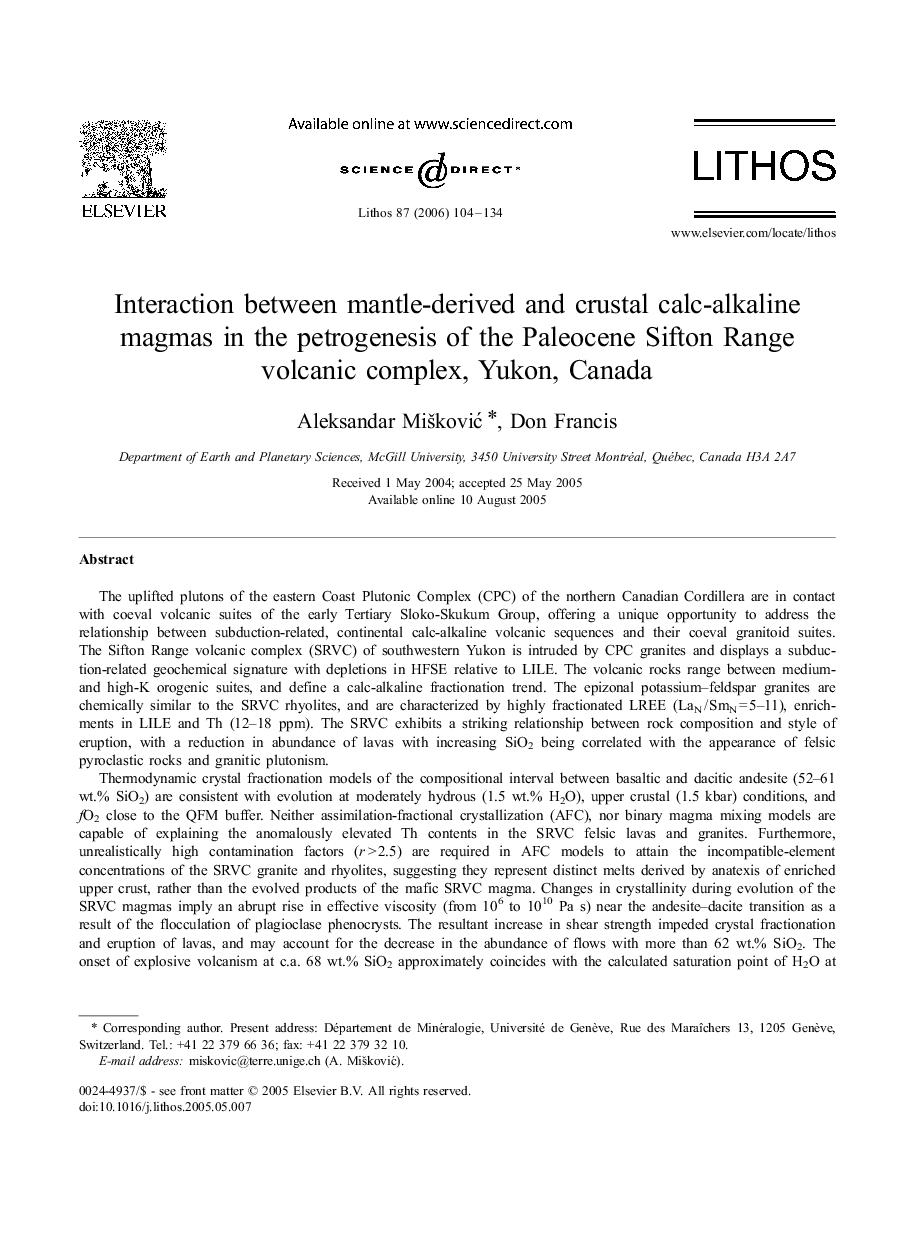| کد مقاله | کد نشریه | سال انتشار | مقاله انگلیسی | نسخه تمام متن |
|---|---|---|---|---|
| 4718065 | 1638783 | 2006 | 31 صفحه PDF | دانلود رایگان |

The uplifted plutons of the eastern Coast Plutonic Complex (CPC) of the northern Canadian Cordillera are in contact with coeval volcanic suites of the early Tertiary Sloko-Skukum Group, offering a unique opportunity to address the relationship between subduction-related, continental calc-alkaline volcanic sequences and their coeval granitoid suites. The Sifton Range volcanic complex (SRVC) of southwestern Yukon is intruded by CPC granites and displays a subduction-related geochemical signature with depletions in HFSE relative to LILE. The volcanic rocks range between medium- and high-K orogenic suites, and define a calc-alkaline fractionation trend. The epizonal potassium–feldspar granites are chemically similar to the SRVC rhyolites, and are characterized by highly fractionated LREE (LaN / SmN = 5–11), enrichments in LILE and Th (12–18 ppm). The SRVC exhibits a striking relationship between rock composition and style of eruption, with a reduction in abundance of lavas with increasing SiO2 being correlated with the appearance of felsic pyroclastic rocks and granitic plutonism.Thermodynamic crystal fractionation models of the compositional interval between basaltic and dacitic andesite (52–61 wt.% SiO2) are consistent with evolution at moderately hydrous (1.5 wt.% H2O), upper crustal (1.5 kbar) conditions, and fO2 close to the QFM buffer. Neither assimilation-fractional crystallization (AFC), nor binary magma mixing models are capable of explaining the anomalously elevated Th contents in the SRVC felsic lavas and granites. Furthermore, unrealistically high contamination factors (r > 2.5) are required in AFC models to attain the incompatible-element concentrations of the SRVC granite and rhyolites, suggesting they represent distinct melts derived by anatexis of enriched upper crust, rather than the evolved products of the mafic SRVC magma. Changes in crystallinity during evolution of the SRVC magmas imply an abrupt rise in effective viscosity (from 106 to 1010 Pa s) near the andesite–dacite transition as a result of the flocculation of plagioclase phenocrysts. The resultant increase in shear strength impeded crystal fractionation and eruption of lavas, and may account for the decrease in the abundance of flows with more than 62 wt.% SiO2. The onset of explosive volcanism at c.a. 68 wt.% SiO2 approximately coincides with the calculated saturation point of H2O at 1.5 kbar in the hybridized dacite magmas. Alternating mafic and felsic volcanic stratigraphy along with the presence of compositionally bimodal pyroclastics and mixed phenocrysts in the SRVC dacites suggest that mantle-derived magmas and crustal melts coexisted in a zoned magmatic column undergoing episodic injection of juvenile melts. Sudden release of volatiles from the hybrid dacitic magmas along the interface with the overlying anatectic crystal mush may have triggered the cycle of explosive eruptions of dominantly rhyolitic ejecta. The consequent loss of volatiles further promoted feldspar crystallization eventually favouring magma stagnation and plutonism.
Journal: Lithos - Volume 87, Issues 1–2, March 2006, Pages 104–134